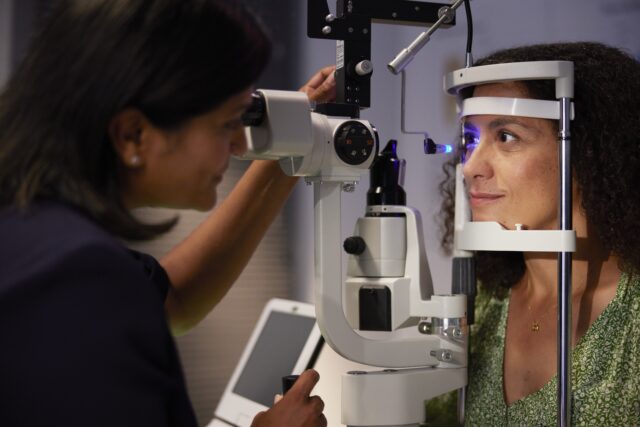BEING able to see clearly is so important in allowing us to carry out everyday activities – yet we often take our sight for granted. Specsavers have outlined key things that residents across the London region need to be aware of with regard to eye health.
Research from Specsavers shows that 40% of people have delayed having an eye test, even when they felt they needed one, and 38% have never considered that they could suffer from significant sight loss.
Regular eye tests are essential in not only checking for any changes to our vision but our health as well. However, not everyone is fortunate enough to have access to these services.
That is why Specsavers has been supporting Vision Aid Overseas for more than 10 years to help provide optical aid and services to developing countries in Africa. During this time it has contributed £1.6 million to the charity and 400 Specsavers volunteers have been to Zambia to offer their services. They have helped to carry out 283,750 eye tests and dispensed 83,447 glasses to those who need them. The partnership has also meant that 11 vision centres have been able to open too.
To mark the 10-year partnership, this World Sight Day (October 14), Specsavers is continuing to fundraise for the charity and is also highlighting 10 things our eyes can reveal about our health.
Giles Edmonds, Specsavers clinical services director, explains the signs we can spot and those that can be picked up during an eye test.
Glaucoma
‘Glaucoma is often symptomless as it develops so gradually. That’s why it is often referred to as the silent thief of sight,’ says Mr Edmonds. ‘It is one of the leading causes of blindness, however, if it is identified in its early stages it can be successfully managed. Regular eye examinations are key to detecting it – and are so important to those at greater risk of the condition due to their older age or family history.
‘At Specsavers we use advanced diagnostic equipment called OCT (Optical Coherence Tomography) to examine the eye in more detail and are able to pick up any damage to the optic nerve which is typical of glaucoma.’
Diabetic retinopathy
‘In its early stages diabetic retinopathy usually doesn’t pose any noticeable symptoms, so an eye test can pick it up before you do,’ Mr Edmonds says. ‘As the condition affects small blood vessels in the eye, damaging the retina, your optometrist can look for early characteristic changes, such as tiny leaks from these damaged vessels.’
High blood pressure
‘During an eye test, your optometrist might spot signs of high blood pressure, through observing the eye’s blood vessels to see if they have narrowed or started leaking. Patients with high blood pressure can develop a condition called hypertensive retinopathy which sees the walls of blood vessels thicken, narrow and restrict blood flow. In some cases the retina also becomes swollen and the blood vessels can leak.’
Red spots/blood vessels
‘Red spots on the front of your eyes can often be caused by broken blood vessels from something as simple as a cough or a sneeze,’ says Mr Edmonds. ‘While in most cases they are nothing to worry about, if your eyes remain red for some time it is important to get them looked at as it could be an indication of high blood pressure.
‘High blood pressure can mean you have a higher risk of a heart attack or stroke and it can also lead to complications with your vision.’
Persistent floaters
Mr Edmonds says: ‘Floaters are spots in your vision and usually look like black or grey specs or cobwebs that drift about when you move your eyes. Most people will experience floaters in their vision at some point in their life – particularly as we reach older age as the jelly-like substance in our eyes becomes more liquid.
‘If you notice more eye floaters than usual, a sudden onset of new ones, flashes of light in the eye or darkness on any side of your vision, you must get it looked at immediately as it could signify a tear in your retina or injury in the back of your eye. In some cases, it can also be a symptom of diabetic retinopathy or high cholesterol.’
Blue ring
‘Some people may notice a blue-tinted ring appear around their iris, particularly as they age,’ says Mr Edmonds. ‘This is caused by cholesterol deposits in the eye. They are more common in those aged 60 and above and aren’t usually something to worry about. However, if these develop in the under 40s, there may be a greater risk of developing heart disease.’
Yellow tinge
‘Typically, yellowing of the eyes is caused by jaundice,’ says Mr Edmonds. ‘The condition occurs when haemoglobin (part of the blood which carries oxygen) breaks down into bilirubin, which isn’t then cleared from the body. It is meant to move from the liver to the bile ducts, but if this doesn’t happen yellowing of the skin – and the eyes – can occur and could signify there is a problem with the liver, gallbladder or pancreas.’
Blurred vision
‘Blurred vision can be caused by many things and it is vital you get it checked out. Diabetes raises the risk of experiencing diabetic retinopathy where high blood sugar levels damage tiny blood vessels in the eye that sense light which can result in blurry vision.
‘The sudden onset of blurry vision could also be a sign of stroke, particularly if combined with some of the other key signs such as slurred speech and dropping of the face. Blurry vision could also indicate other eye conditions such as cataract or age-related macular degeneration too.’
Arthritis
‘As well as causing inflammation of the joints, some autoimmune diseases, such as rheumatoid arthritis, can also cause inflammation in the eyes,’ Mr Edmonds says. ‘This inflammation usually leads to dry eye but occasionally it can cause more serious conditions like inflammation of the iris.’
Tumours
‘While an eye test can look for any cancers of the eye such as melanomas, it will sometimes reveal signs of possible brain tumours,’ Mr Edmonds says. ‘Swelling in the optic nerves can be visible during an eye test and can sometimes indicate that a brain tumour is present.’




